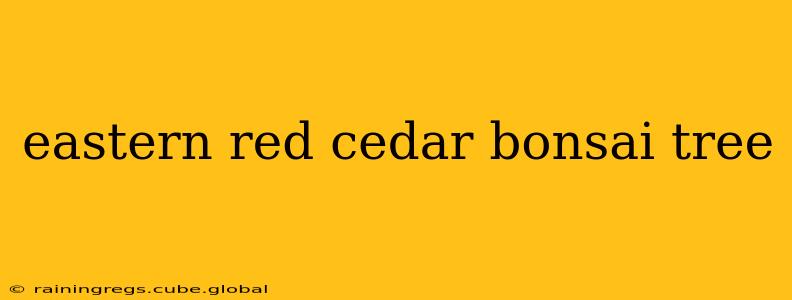The Eastern Red Cedar ( Juniperus virginiana) boasts a naturally graceful form, making it a popular choice for bonsai enthusiasts. Its adaptability and resilience make it a relatively forgiving subject, though understanding its specific needs is crucial for success. This comprehensive guide will delve into all aspects of cultivating a stunning Eastern Red Cedar bonsai, addressing common questions and providing expert tips.
What Makes Eastern Red Cedar a Good Bonsai Tree?
The Eastern Red Cedar's popularity in bonsai stems from several key characteristics. Its fine textured foliage, ability to withstand pruning and shaping, and tolerance of various conditions contribute to its appeal. It readily forms attractive jin (deadwood) and shari (exposed deadwood branches), adding character and visual interest to the finished bonsai. Furthermore, its relatively fast growth rate allows for quicker progress in shaping and styling.
How to Care for an Eastern Red Cedar Bonsai
Caring for an Eastern Red Cedar bonsai involves understanding its specific requirements for light, watering, feeding, and pruning.
Light Requirements:
Eastern Red Cedars thrive in full sun, receiving at least six hours of direct sunlight daily. Insufficient light can lead to weak growth and elongated branches, hindering the bonsai's development. Ensure your bonsai receives ample sunlight, especially during the growing season.
Watering:
Consistent moisture is essential, yet overwatering can be detrimental. Allow the soil to dry slightly between waterings. The frequency will depend on factors such as pot size, weather conditions, and season. During hot, dry periods, you may need to water more frequently.
Feeding:
Feed your Eastern Red Cedar bonsai regularly during the active growing season (spring and summer) using a balanced, slow-release bonsai fertilizer. Avoid over-fertilizing, as this can damage the delicate root system. Reduce or cease feeding during the dormant period (fall and winter).
Pruning and Shaping:
Regular pruning is crucial to maintain the bonsai's shape and size. Pinch back new growth throughout the growing season to encourage denser foliage. More significant pruning and shaping should be undertaken in late winter or early spring before new growth begins. This allows the tree to heal properly before the onset of active growth.
How Often Should I Repot My Eastern Red Cedar Bonsai?
Repotting should be done every 2-3 years, typically in late winter or early spring. This process allows for refreshing the soil, pruning the roots, and adjusting the planting depth as needed. Use a well-draining bonsai soil mix to prevent root rot.
What Kind of Soil is Best for Eastern Red Cedar Bonsai?
A well-draining bonsai soil mix is crucial for the health of your Eastern Red Cedar bonsai. A suitable mix would consist of a blend of akadama, pumice, and lava rock, providing good aeration and drainage while retaining some moisture.
What are the Common Problems with Eastern Red Cedar Bonsai?
While generally hardy, Eastern Red Cedars can be susceptible to certain issues. These include pests such as spider mites and scale insects, as well as diseases like cedar apple rust. Regular inspections and prompt treatment are vital in preventing serious problems.
How Do I Propagate Eastern Red Cedar Bonsai?
Propagation can be achieved through cuttings or seeds. Cuttings are generally more successful, taken in spring or summer from semi-hardwood growth. Seeds require stratification (a cold period) before germination.
Is Eastern Red Cedar Bonsai Difficult to Grow?
While Eastern Red Cedars are relatively easy to cultivate as bonsai compared to some species, success requires dedication and attention to detail. Mastering the techniques of pruning, watering, and fertilization are key to producing a healthy and aesthetically pleasing bonsai. Consistent monitoring for pest and disease issues is also vital.
This guide provides a solid foundation for cultivating a thriving Eastern Red Cedar bonsai. Remember, patience and observation are key to success in this rewarding horticultural pursuit. With diligent care and attention, you can cultivate a beautiful and long-lasting bonsai that will bring joy for years to come.
